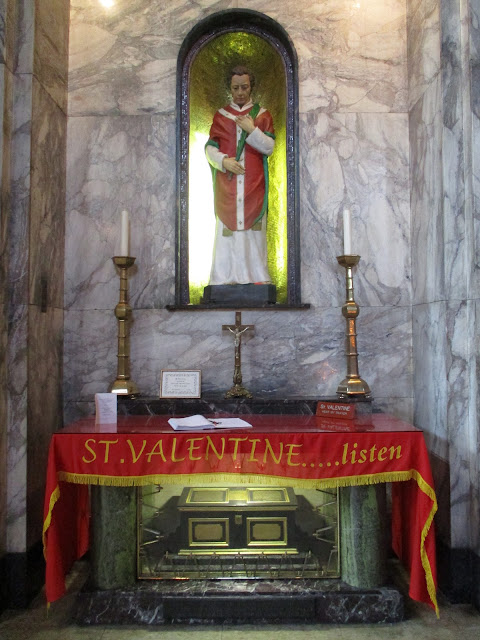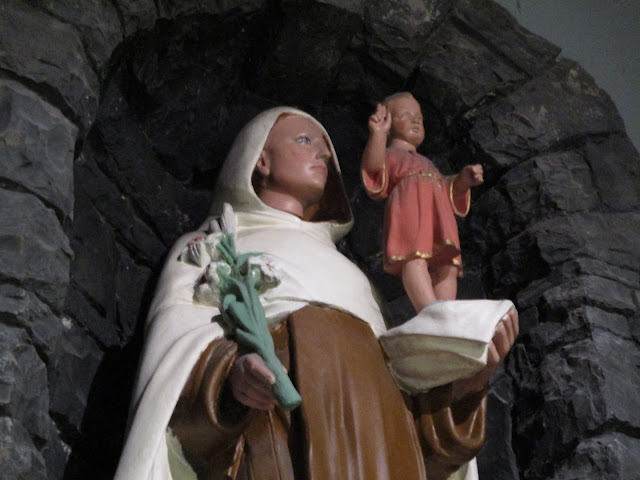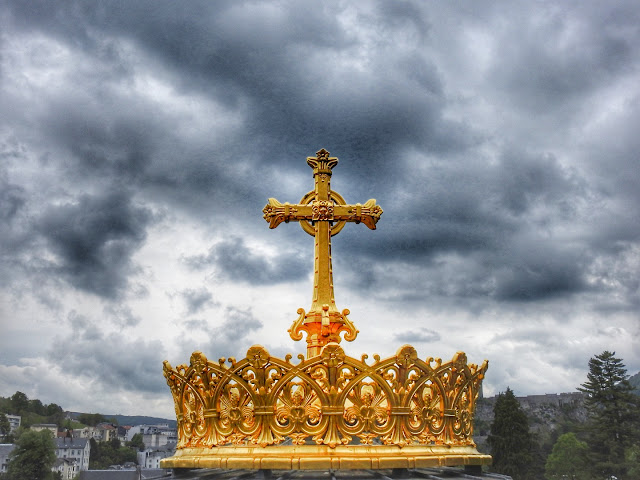Today, pilgrims stand and pray at the sacred site of the ancient well which lies outside the walls of St Patrick's Cathedral.
Devotees to the Saint still walk on pilgrimage to sites all over Dublin, following in the footsteps of the great Saint.
This devotion, many centuries after this man walked on Ireland's green hills, give rise to the question;
Who was Patrick?
Ancient Ireland
Ireland was the last piece of land on the journey west; it was known as 'the back of beyond'.
In Latin this translated as ultima Thule; the voyage's last stop.
Celtic culture held full sway over the island when the young Patricius arrived, having been captured as a slave.
In the fifth century AD, Ireland's population depended on mixed farming and the rearing of cattle and sheep.
There were no cities as we know them today. Instead, early Celtic settlements had ring-forts enclosing the dwellings.
Thick forests covered large areas of the land, and about one hundred chieftains ruled as clan kings.
Within one hundred years after the death of Patricius - eventually known as Patrick - the influence of this man of God had led to the warrior-kings converting to Christianity.
Patrick's early life
Patrick grew up in a place called Bannavem Taberniae - possibly in Britain.
His father, Calpurnius, was a local governing official who was also a deacon in the Church.
Potitus, Patrick's grandfather, was a priest - a presbyter.
The family lived in a villa on a farm, and owned slaves, to whom Patrick was very attached.
They were devout Christians, and Calpurnius' role in the Church included duties during worship and visiting Church members when they were sick or in need.
Around 400 AD, before his sixteenth birthday, Patrick was abducted from his home by slavers.
His enslavement abruptly interrupted his education, and in later years this sad fact deeply affected Patrick.
He felt that he had not been as well educated as many of his peers, and this had impact on his self image and mood.
However, this did not affect his ministry, which flourished under his God-given vocation to preach, teach, and covert to Christ.
Slavery in Ireland
Many thousands were enslaved alongside Patrick that fateful day.
A ship had come in from Ireland in search of plunder and valuable slave labour.
At that time, large slave markets flourished in early Dublin, with buyers coming in from all over the known world.
In the Iron Age, Roman power was gradually declining towards the end of the 3rd century.
Britain fell prey to attacks from those closest to her borders.
Irish chieftains raided across the water and expanded their territories eastward.
The kingdom of Dalriada in the north-east extended into northern Britain and Scotland.
This created a route for some of the first Irish missionaries.
Most famous of raiders and slavers was Niall of the Nine Hostages.
It is said he controlled land through hostages taken from the Scots, Saxons, Britons and Fench, as well as Irish. [1]
He is reportedly credited with capturing the young Patrick and bringing him back to Ireland as a slave in the middle of the 5th century.
Mound of the Hostages
It is believed, prior to being sold, Patrick was held at the Mound of the Hostages on the Hill of Tara.
Patrick became the slave of a master on a farm near the woods of Foclut, by the western sea in County Mayo.
It is believed that the master was a warrior chief, whose opponents' heads sat atop sharp poles around his palisade in Northern Ireland.
Patrick became a herder, protecting the animals from attack by wild animals.
He toiled in his duties, battered by wind and rain, on the side of Slemish Mountain. [2]
His life as slave in Ireland was a harsh one, and he endured long bouts of hunger and thirst. [3]
He also lived in complete isolation from other human beings for months at a time - a psychologically searing experience indeed.
Patrick worked as a slave from age 16 until he was 22 on this mountain.
The mountain - which rises to 1,500 feet - lies in County Antrim.
During this time of trial, Patrick's relationship to God - not very deep initially despite his Christian upbringing - strengthened and deepened.
One of his continually used prayers was eventually woven into a song called 'St Patrick's Breastplate' [the [Lorica]].
One verse reads;
'Christ be with me, Christ within me,
Christ behind me, Christ before me.
Christ beside me, Christ to win me,
Christ to comfort and restore me;
Christ beneath me, Christ above me,
Christ in quiet, Christ in danger,
Christ in hearts of all that love me,
Christ in mouth of friend and stranger.'
Lifted up high
Patrick placed trustful reliance on the creed, and experienced numerous dreams and visions sent by God.
In one vision Patrick saw himself portrayed as a lifeless stone. The Almighty took hold of the stone of Patrick, lifted him from the mud, and set him on top of the wall.
The inference was clear; what was slave and seen as of low consequence was about to be made leader; to be lifted to a position of pivotal importance in God's Holy Service.
Escape from Captivity
One night, in his sleep, Patrick heard a voice saying to him,
'It is well that you fast, soon you will go to your own country.'
Again, after a short while, he heard a voice saying, 'See, your ship is ready'.
In obedience to this heavenly message, Patrick made a break for freedom.
After six years of slavery, he started on the two hundred mile journey to the east coast.
When Patrick arrived at the ship which had been foretold, it had already raised anchor for sail.
The crew - initially reluctant to take him on as passenger - eventually relented.
They set sail with Patrick safely on board.
After three days at sea, all disembarked on the opposite shore.
It is uncertain whether they landed in Britain or France.
Homecoming and Priesthood
From there Patrick made his way home again, where his parents gave him warm welcome.
Despite his joyous return, this young man - susceptible to dreams, visions and the moods they bring - was not the same young lad who had been abducted.
His whole outlook had changed, and he now tended towards the Church.
Patrick underwent Church training near his home in Britain.
It is probable he received further training in a Gaul Monastery in preparation for ordination.
It is thought that Patrick received guidance from Germanus, Bishop of Auxerre in France.
Trial by friendship
Patrick was broken hearted when a close friend betrayed his confidence.
He had confided a past life difficulty to this person who then took the opportunity to shame him publicly.
This affected Patrick's position in the Church, and the experience affected him greatly.
God Himself comforted the mortified and betrayed Patrick.
This He did by means of prophetic dream.
The dream proved fortuitous for Patrick, who had been left deeply shaken by the recent events.
His confidence had been affected by his embarrassment and inner sufferings.
In the dream, Patrick saw his own face on a coin. The head of Roman emperors were often engraved on coins with words of honor and praise inscribed in letters around the head.
In Patrick's dream, the words surrounding his head were words of disgrace and shame.
Then he heard God's Voice, saying, 'We have seen with displeasure the face of Deisignatus.'
God disapproved of the words which attempted to tarnish Patrick's reputation.
Patrick arose from the dream, comforted and resolved.
Call to Ireland
Patrick felt called to return to Ireland after a prophetic dream.
In this dream-vision, he saw a man called Victoricus standing in front of him.
In his hand he held a countless letters.
Victoricus gave Patrick one of them, and he read the opening words of the letter, which were 'The voice of the Irish'. [4]
At the same moment he read the beginning of the letter, he thought he heard their voices - they were those beside the Wood of Voclut, which is near the Western Sea - and they cried out as one,
'We ask thee, boy, come and walk among us once more.'
A series of dreams and visions prepared Patrick for his great task ahead; they contained warnings and encouragement for the difficult task that lay ahead.
It turned out to be no less than the evangelization of an entire nation.
Patrick was commissioned as a bishop to serve in Ireland; and set sail back to the very land he had fled before.
Ministry in Ireland
Patrick wasted no time once back on Irish soil.
He tramped all over Ireland, serving as Bishop.
Patrick preached the Word of God, baptized the people into Christianity and celebrated the sacraments.
It is said among the local people in Dublin that Patrick used to wade through a ford near the River Liffey - [the ford no longer extant] - in order to reach the higher hill area where the present day Church of St Audoen stands. [5]
One day as he was wending his way up the hill Patrick stopped, leaned on his staff and looked over the whole wooded area.
It was apparent he had just seen a vision, and he declared that where there was just ford, wood and settlements,
"One day there will rise a magnificent city, as far as the eye can see."
That prophecy came true; the extended city of Dublin lies in that very area, as far as the eye can reach and further.
Many pilgrims still walk in the footsteps of Saint Patrick.
From the present day Church of St Audoen, it is a short walk to where countless Irish were baptized by the great Saint.
Patrick baptized royalty and villagers, kings and shepherders alike.
Well of Saint Patrick
The well of Saint Patrick - no longer extant, but commemorated down the centuries and marked by a plaque in the grounds of Saint Patrick's Cathedral Dublin - was the site of the mass baptisms.
In 1901 building works beside the Cathedral unearthed six Celtic grave slabs. These were subsequently dated to the 10th century.
One of these large stones covered the remains of what looked like an ancient well.
It is possible that this is the same well which Saint Patrick used in the fifth century.
The presence of the stones [still to be viewed in the Cathedral] prove that the site has been in use for at least one thousand years.
The first record of there being a building was in 890 AD when Gregory, King of Scotland, visited a church.
The decision to build a church there was probably based upon the close connection with the Saint.
In 1190 the site was chosen by Archbishop John Comyn to be raised to Cathedral status and eventually the wooden church was replaced with the great structure which can be viewed today. [6]
Confession
More than fifteen hundred years ago Saint Patrick wrote a Letter in Latin.
At a later stage he authored a personal account of his work as a bishop of Ireland, called his Confession.
The Confession and the Letter to the soldiers under the command of Chieftain Coroticus are recognized as authentically the work of Patrick.
Written in the 9th century, The Book of Armagh contains accounts of St Patrick's life, a copy of St Patrick's own Confessio, as well as a complete New Testament.
It was written by the monk, Ferdomnach, who died in 846 AD.
According to this book, Patrick asked the local chieftain for a site on which to build his church.
The chieftain, Daire, refused Patrick the site he requested.
He gave him instead the place now called 'St Patrick's Fold' or 'Ferta Martyrum', in the present Scotch Street. [7]




















